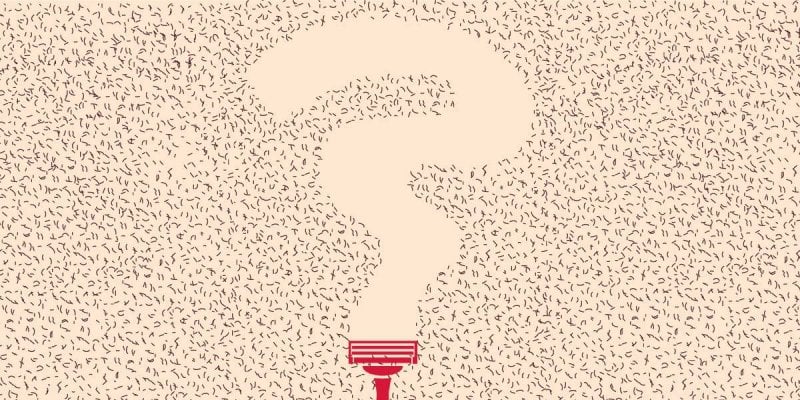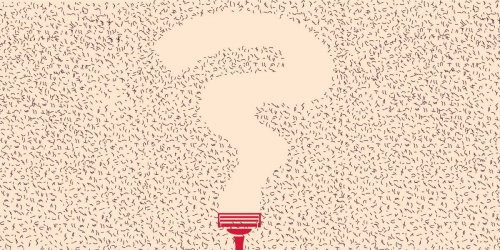Al-Bukhaari and Muslim narrated from Abu Hurayrah that the Prophet (PBUH) said: “The fitrah is five things – or five things are part of the fitrah – circumcision, shaving the pubes, cutting the nails, plucking the armpit hairs, and trimming the moustache.”
What is to be done with hair on various body parts, and more precisely how it should be dealt with in the most “Islamic” way possible are questions that have occupied Muslims in the Arab world and beyond for many years. If that task was not time-consuming enough, several fatwas based on various hadiths discuss the practice of shaving using a razor, referred to in Arabic as tahdid, aiming to educate the masses on what practices are considered religiously permissible (halal) and which are forbidden (haram).
To shave or keep a beard?
According to a hadith of Ibn ‘Umar’s, Muslim men are obligated to keep their beards as a means to differentiate them from the kuffar or non-believers. Narrated By Nafi' : Ibn Umar said, The Prophet said, 'Do the opposite of what the pagans do. Keep the beards and cut the moustaches short.' For some, the hadith reflects what is mustahabb or advisable as part of the Sunnah. For others, the hadith is religious law and shaving the beard is seen as haram. According to Sheikh Ibn Taymiyah, those who imitate the kuffar on the outside- even by shaving the beard- will begin to imitate their bad deeds, habits, and beliefs, thus leading them on a slippery slope of non-belief. Alternatively, most Islamic scholars and schools of thought agree that the mustache should be faded or trimmed to ensure hygienic practice so the hair does not touch the lip. Along the lines of hygiene, Muslim men are also instructed to keep their beards at an appropriate length, which, according to Abu Huraira is a fist length. Chin scruff and light stubble do not cut it. Beards today occupy an interesting aesthetic spectrum and an important political position. The image of the terrorist with his fully grown beard is so intimately linked to Islam (despite the prevalence of beards in various cultures) and so widely proliferated in international media as symbolic code red. Arab and Asian men (read: persons of color), regardless of their religious affiliation, are routinely stopped and frisked at airports. On the other end of the spectrum, we have the internationally accepted beard, the one worn by men of lighter skin as a marker of liberal politics; the indie-loving “hipsters” of the world. Thus, despite Islamic scholars’ focus on the minute details of aesthetic appearance, there exists a bearded double standard that ideologically widens the chasm between “Muslims vs. Others”.What About the Head?
If you thought the fatwas and hadiths on hair removal stopped at beards, think again. According to Islamic scholars, there are only several kinds of head shaving that are permissible: when performing Hajj, ‘Umrah, shaving a child’s head on the seventh day after birth as per a hadith narrated by al-Tirmithi (“The Messenger of Allaah offered a sheep as ‘aqeeqah for al-Hasan, and said: ‘O Faatimah, shave his head and give the weight of his hair in silver in charity.”), when a man converts to Islam, shaving the head as a remedy for a disease. What is impermissible, according to Islamic scholars, is shaving the head in a way that resembles immoral people ( “Whoever imitates a people is one of them,” as narrated by Abu Dawood; classed as saheeh by al-Albaani in Saheeh Abi Dawood), though what this immorality entails remains vague. For all Muslim men wishing to cut their hair in a way that resembles their favorite soccer players, singers, or actors - they, too, should think again. Abu Dawood narrated that the Prophet saw a child who had part of his head shaved and not other parts. He said: “Shave it all or leave it all.” The practice of القزع, which involves removing some hair and shaving others, is not welcome in Islam (goodbye side fades and faux-hawks) and is considered haram if done in imitation of kuffar. On the other hand, Muslim women who are looking to shave their heads for aesthetic reasons or to avoid torturous summer heat are not permitted to do so according to Sunnah. The Standing Committee for Scholarly Research and Fatwa noted that a woman can remove everything except her eyebrows and the hair on her head; it is not permissible for her to remove those, or to remove anything from the eyebrows whether by shaving or any other means”. Removing the eyebrows is considered change in the creation of Allah and is therefore seen as “haram”; however, removing a unibrow is seen as permissible as it is not exactly part of the eyebrows.Pubic Hair & Shaving for Women
As per the article’s opening hadith, it is advised for Muslim men and women to remove pubic hair and armpit hair as a way to remain clean. The Sunnah is to remove pubic hair with a razor and to pluck armpit hair with a tweezer (ouch), but most scholars agree that what matters is removing it, so other depilatory substances are permissible. What is not okay, however, is for someone else to remove one’s pubic hair, so beauty salons for women are strictly unacceptable. Ibn Qudaamah said: “As for a man with another man, each of them may look at that of his companion which is not ‘awrah. And the ruling on a woman with a woman is the same as the ruling on a man with a man.” The shaving situation is increasingly complex for women. While they are allowed to shave their pubic region, armpit hair, thighs, and mustache (though this is debatable as well) they are not permitted to remove their eyebrow hair or shave their heads. Their beautification at salons is considered haram, as per a hadith by al-Bukhari : “May Allah curse the women who do tattoos and those who have them done, those who have their eyebrows plucked, and those who file their teeth for the purpose of beautification and change the creation of Allah”. Yet in an increasingly globalized world, women are expected to abide by international standards of beauty that seemingly contradict those recommended by hadiths and fatwas. These expectations are normalized along an attractiveness spectrum and ingrained in social practices, making it even more difficult for women to be who they wish to be. It appears that a thin line - one may even say a hairline-separates what is permissible from what is not with regards to shaving in Islam. In an increasingly challenging sociopolitical and geopolitical climate, the symbols and meanings attached to the fatwas are rapidly changing. Which hair removal method I choose to use, when and on which part of my body, seem less important in comparison to very real and pressing issues the Muslim world is facing.Raseef22 is a not for profit entity. Our focus is on quality journalism. Every contribution to the NasRaseef membership goes directly towards journalism production. We stand independent, not accepting corporate sponsorships, sponsored content or political funding.
Support our mission to keep Raseef22 available to all readers by clicking here!
Interested in writing with us? Check our pitch process here!






